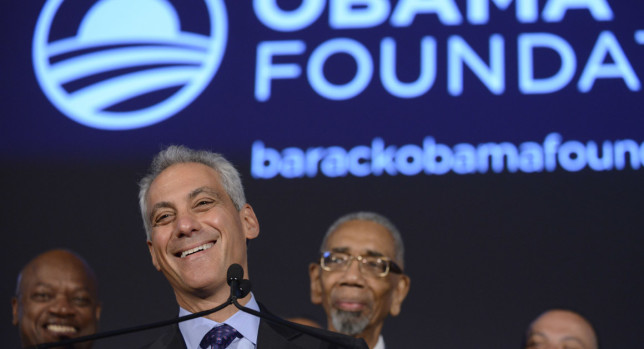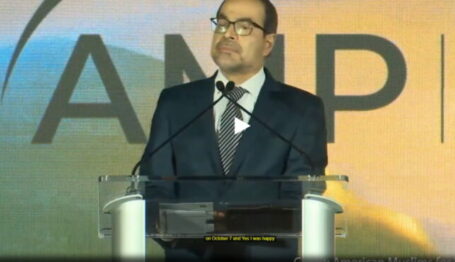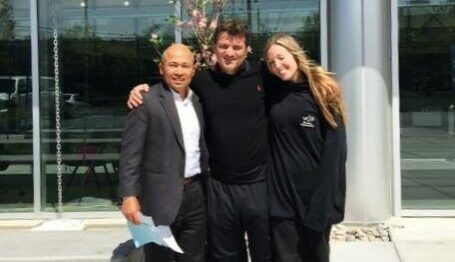Foundation Watch
Billionaire Legacy Builders
Wealth and imagination in the fight to persuade Americans that President Obama has been good for us


(PDF here)
The president has begun raising money for his library and foundation, which will be located in Chicago and plans to operate on a grand scale. Obama hopes to avoid the kind of scandals in which President Clinton’s foundation is mired, and he also hopes his Hollywood friends will be able to embellish a legacy that looks to be mixed at best.
Get ready America. See an entire wing devoted to how President Barack Obama single-handedly killed Osama bin Laden and an even larger wing showing how he provided health care for all Americans. Other exhibits will likely demonstrate how he disarmed Iran, battled Wall Street, and saved the economy from capitalism, along with many other heroic, superhuman, death-defying, unprecedented feats. And he did it all while dealing with snarling Republicans in Congress and Tea Party activists bent on impeding the progress Americans needed, whether they knew it or not.
And you’ll also see all the ways Barack Obama saved the world since leaving the White House, making us all wish that the archaic Constitution hadn’t deprived our country of a third term. Obama will be just 55 years old when he leaves office, comparatively young by presidential standards. He will still have plenty of time both to bask in past glories and to continue trying to fundamentally transform America and potentially the world as an influential private citizen with a foundation, charging six-figure speaking fees along the way. Of course, he’ll also have to fundamentally transform America’s memories of his many catastrophic economic and foreign policies.
Coming sometime in the next decade, it’s the Obama Presidential Library and Museum that will showcase that history, and with it, a global foundation to address world concerns. The president and his supporters have been envisioning this for a while.
A private dinner in February at the White House did not come to light in the pages of the New York Times until August. A group of one-percenters whom Obama and his followers rhetorically loathe in public speeches sat down to talk secretly about Obama’s post-presidency—how history remembers him and what projects he will engage in.
A Presidential Obsession
At least since Jimmy Carter and Richard Nixon, presidents have obsessed over the question of how history will remember them, and to nudge history in the right direction, they have built shrines to themselves in some form. This so-called “edifice complex” is particularly strong when most of the public regards a president’s administration as a failure—as polls show is the case with Obama.
During the VIP dinner, one of the guests, LinkedIn founder Reid Hoffman, said “Feel free to kick us out,” Hoffman recalled to the New York Times.
Obama let the gathering know who was in charge. “I’ll kick you out when it’s time,” he said, according to the Times.
The gathering went on until 2 a.m. The 13 guests included liberal novelist Toni Morrison, a celebrity Obama supporter who previously called Bill Clinton “the first black president”; the hedge fund manager Marc Lasry, an Obama donor who had to decline a nomination for ambassador to France because of alleged ties to the Russian mob; the Silicon Valley venture capitalist John Doerr, an ally of Al Gore and booster of green projects; Chicago media mogul and Democratic dark money man Fred Eychaner (see Foundation Watch, Sept. 2015); actress Eva Longoria, a liberal activist with questionable nonprofit activities; Sun Microsystems co-founder Vinod Khosla, another major Obama donor who has also given scattered amounts to Republicans; and author and journalist Malcolm Gladwell, now at the New Yorker, but formerly a writer for the American Spectator. Gladwell told the Times that Obama “seemed incredibly relaxed.”
The somewhat unseemly meeting in the people’s house was to shore up support for Obama’s presidential library and post-presidential foundation, the Times said. Obama reportedly did not ask any of the guests for a donation, but when the president invites rich people to the White House with his foundation as the topic du jour, he doesn’t have to ask.
“Where we’ll end up, I don’t know yet,” said Marty Nesbitt, the president’s longtime buddy from Chicago who is heading up planning for the Obama legacy, including the library and global foundation (New York Times, Aug. 17, 2015). But Nesbitt has some ideas.
The goal is to raise $1 billion for the presidential library and foundation. That is about twice the amount raised for the George W. Bush library and related programs. The Times also reported the plan is to establish a “digital first” presidential library, with various modern technologies allowing a worldwide reach, so someone across the world can take a virtual tour and learn about the spectacular legacy of hope and change in America. Obama’s supporters from Hollywood and Silicon Valley are all in on the idea, with advisors ready to step up and help with the planning. One may reasonably assume their benevolent support for the president and his policies could later mean nice contracts for the Hollywood and Silicon Valley communities.
Still, hitting the $1 billion mark could take some time. The planning process began in December 2012, soon after Obama won his second term. The president actually began talking about it with director Steven Spielberg and actor Daniel Day-Lewis at the White House screening of Lincoln, a flick that would likely cause any president to start thinking about his legacy at least a little. Then again, the rarely humble Obama—or at least his surrogates and sycophants—have compared his presidency to those of Abraham Lincoln, Franklin Delano Roosevelt, John F. Kennedy, and Ronald Reagan at one point or another (Time, April 10, 2014).
But in 2014, the effort raised just $5.4 million. In the first quarter of 2015, it raised another $1.75 million for the complex, which is to be built on the University of Chicago campus. At press time, the project was searching for an architect. Organizers say the real fundraising will not kick in until after Obama leaves office (Politico, July 15, 2014).
Not surprisingly, the big donors to the library/foundation overlap with donors to Obama’s two elections campaigns, the Democratic National Committee, and Obama’s activist group, Organizing for Action. Many of these big donors were rewarded with frequent visits to the White House, and in some cases, cushy presidential appointments. It will be interesting to see how much they will open their wallets when there is no longer a potential for a mutual payoff, as the Clintons always craftily left open.
Certainly some of the donors to the Bill, Hillary, and Chelsea Clinton Foundation enjoyed influence, even after Bill Clinton was out of office, with Hillary in the Senate before serving as secretary of state with well-known presidential ambitions. (The Clinton Foundation was most recently profiled in the May 2015 Foundation Watch.)
Comparing the spectacle of the Clinton library and foundation—which has brought endless controversy for that former first family—is difficult. To avoid such problems, Obama and his supporters reportedly want to avoid the ethical morass that the Clintons created for themselves with their endlessly shady dealings. One way the Obama clan plans to do this is by keeping the presidential library and foundation as two arms of a single organization.
That approach differs from the Clinton’s, whose library is based in Little Rock, while the Clinton Foundation is based in New York. Obama’s Chicago-based library will also house his foundation—a one-stop shop for Obama fans.
“His [Clinton’s] physical presence is separate from his library,” Nesbitt told Politico. “We will be all in one place. Everything that the president does will be from one central entity.”
Though nothing adequately compares to Clinton’s post-presidency, most of the other presidential libraries and museums fall far short of Obama’s ambitious plan. Only the last 13 presidents have official presidential libraries. Even Think Progress, a high-profile blog of the left-wing Center for American Progress, couldn’t help pointing out how extravagant these libraries have become.
The JFK library included an endowment for an institute at Harvard University and cost $20.8 million. Adjusted for inflation, that would be $72.1 million today. The Reagan presidential library cost $60 million when it was built, or $130 million in today’s dollars. The Clinton Foundation has at least $2 billion, but the library itself cost $165 million. Thus, Obama hopes to surpass all of his predecessors (Think Progress, Aug. 25, 2015).
A top aide told the Times that Obama respected George W. Bush’s choice to stay out of the public eye in his post-presidency, but also admired the way Bill Clinton used his political skills to press his agenda as a private citizen. Considering that Obama lacks the personal touch of Clinton, and reportedly doesn’t particularly like dealing with other people, it’s possible to imagine him laying low after he exits the White House. But it seems unlikely he’ll let his oratorical skills, which made him an effective campaigner despite his aloofness, lie fallow. Moreover, having left such a poor legacy behind, it’s almost certain that Obama will seek to take the Jimmy Carter route of trying to make his mark as an ex-president.
With deep ties to the Obama family, Nesbitt is an interesting choice to run the organization. Unlike Obama before he moved into the White House, Nesbitt actually has some experience in running something. He is CEO of the Vistria Group, a private equity firm. Nesbitt and wife, Dr. Anita Blanchard, contributed between $200 and $100,000, according to the Obama Foundation, which is the bizarrely wide range on the organization’s disclosure forms (Chicago Business, Jan. 15, 2015).
Nesbitt still lives on the South Side of Chicago, the same neighborhood where he first met Obama the community organizer in the 1980s on a basketball court. Along with their wives, they ended up playing Scrabble together. Nesbitt said he and Obama spend so much time talking on the phone and in person that he doesn’t remember the exact day they met or when he was asked to run the foundation (Politico, Aug. 20, 2015). Nesbitt has spent time traveling to other presidential libraries to get ideas and to better understand the successes and mistakes others have made.
Both Obama and Nesbitt were raised by single mothers but went to private schools. Nesbitt’s wife, Blanchard, delivered both of Obama’s children. Nesbitt also bought the Hawaii home featured in the TV show “Magnum P.I.” for $9 million, as a vacation home that would be close to the Obamas (Politico, March 19, 2015).
Just as Obama has described his final two years as the “fourth quarter” of his presidency, Nesbitt says of the post-presidency: “This is definitely the first inning. I don’t even think there’s an out in the first inning. We’re early in the process. We’ve done a lot of homework, we know who we’re playing, we know what the lineups are, we know who is pitching. But it’s early” (Politico, Aug. 20, 2015).
The library/foundation will return to Obama’s community organizer roots by naming a “community engagement director.” The foundation will continue some incarnation of “My Brother’s Keeper,” Obama’s highly controversial mentoring program for black youth. Further, it will have what Politico called a “scaled down” version of Organizing for Action, to rally support to left-wing political causes.
The presidential library/foundation will also partner with academia. With so many professors on the far left, there will presumably be much enthusiasm for this, except for those who think Obama was too conservative. One already would expect the University of Chicago to be closely associated. But planners anticipate also working with the University of Illinois at Chicago, as well as Columbia University, and a satellite location in Hawaii. “We want to be able to have that academic perspective, to add to the social perspective,” Nesbitt said.
Enviros Oppose
In one delicious bit of irony for a president who consistently pandered to the environmental lobby, the foundation will face opposition from a Chicago environmental group, Friends of the Parks—which objects to any development of parks across the Windy City.
The foundation will pick a location in the first quarter of 2016, and there are two finalists. One potential site is close to Jackson Park, southeast of the University of Chicago campus. It would be close to the law school where Obama taught. The other is near Washington Park and lies to the northwest of the University of Chicago campus, close to the home where the Obamas lived before moving to the White House, the one they attained in a shady deal with Tony Rezko. Both parks were reportedly designed by famed landscape architect Frederick Law Olmsted.
The sites are similar because they are in neighborhoods that have faced hardship and could use an economic boost. Community playgrounds would be removed but replaced, organizers say. Further, local contractors would be hired for construction. Nesbitt called it “an economic development catalyst for the area that the president and first lady call home.” The Chicago City Council voted 47-0 to set aside 21 acres either from Washington Park or Jackson Park, for the Obama library.
Friends of the Parks isn’t yet convinced and is threatening a lawsuit to block construction.
Help From The Mayor
Chicago Mayor Rahm Emanuel, Obama’s former White House chief of staff, is pushing the Illinois state legislature to take action to discourage lawsuits aimed at halting either the Obama museum or the museum for Star Wars creator George Lucas.
Protecting parkland from a museum dedicated to Chewbacca and Darth Vader could be an easier public relations case to make than blocking a museum to the hometown politician who made it all the way to the White House, as Emanuel seemed to acknowledge in keeping the focus on the Obama library:
“See this as an opportunity for the city in which you’re a part of and you love. We will work with you on issues as it relates to parks and parkland. We’ve done it even before this,” Emanuel said in remarks addressed to the Friends of the Parks. “We all collectively added 750 acres in the last four years. We can make this a win-win situation.… Friends of the Parks—their aspirations are something I share, [but] this is something unique. You’re not setting a precedent.… There won’t be another presidential library for a while. So this is a once-in-a-lifetime. Let’s all be on one team: the Chicago team” (Chicago Sun-Times, April 21, 2015).
The Star Wars museum lawsuit is relevant because it established a legal precedent when a federal judge ruled the Friends of the Parks has legal standing to stop the Star Wars museum planned for McCormick Place convention center in Chicago.
Former Friends of the Parks director Cassandra Francis warned about what the city was trying to do, regardless of any good intentions. “It is a very slippery slope. If we emasculate the lakefront protection ordinance—the local Chicago embodiment of the public trust doctrine—we will have a very difficult time stopping anything further on the lakefront,” Francis said (Chicago Sun-Times, April 21, 2015).
The group’s attorney Tom Geoghegan told the Sun-Times: “Whether or not the construction of those structures—land recovered from the waters of Lake Michigan—was a violation of the public trust doctrine is a question that belongs to the past. It’s over. It’s settled. They’re there. What we’re concerned with is that there be no more breaches of the public trust doctrine if any occurred in the past,” he said speaking of the Star Wars case. “What this suit is intended to do is to ensure that the lakefront is protected in the future. There is not that much space left. And we have to hold on and fight for what we have.”
Unsavory and Politically Connected
Even if Team Obama avoids the same conflict of interest pitfalls that have dogged the Clinton Foundation for almost two decades, it already has a strong contingent of shady donors. And those who are not unsavory are generally politically connected. Obama is not drawing donations from civic-minded folks concerned about preserving history.
In the unsavory category is Marc Lasry, with a net worth of $1.89 billion according to Forbes. He bundled more than $500,000 for Obama’s 2012 re-election campaign and contributed $9,600 of his own money to Obama’s two presidential campaigns. He runs the $12 billion investment firm, Avenue Capital. Obama tapped him to be ambassador to France.
Lasry, however, had to opt out of the position (New York Post, April 26, 2013). A close Lasry friend, Illya Trincher, and 30 others were charged with running the New York arm of a $100 million betting and money-laundering racket, the New York Post reported. Lasry reportedly turned down the ambassadorial position shortly after the White House asked the FBI to look into whether the billionaire was tied to anyone involved in the enterprise. The poker games were for the rich and powerful and allowed bets of up to $2 million, held in a lavish $20 million Manhattan apartment. One of the defendants in the case included a Russian national associated with the Russian mob, who is also accused of seeking to fix the skating competition at the 2002 Winter Olympics.
Though Lasry didn’t talk about why he withdrew from his ambassadorial aspirations, an Avenue Capital spokesman told the New York Post, “Marc withdrew because it was becoming difficult to receive a waiver of the ‘key man’ provision from Avenue Capital’s investors, and he would have had to divest himself of his Avenue Capital business holdings.”
Sports commentators have also criticized Lasry. As the owner of the Milwaukee Bucks, he hired Jason Kidd to be head coach, despite Kidd’s legal problems (Kidd pleaded guilty to hitting his ex-wife and to a misdemeanor drunken driving charge).
Still, these issues weren’t enough to keep Lasry out of the White House for the legacy-building dinner in February.
Star Power
Another donor at that same dinner party was actress Eva Longoria, who co-founded the purportedly nonpartisan Latino Victory Project, with the announced goal of raising Latino voices in the political dialogue. Longoria was also a co-chair of Obama’s re-election campaign in 2012. The other co-founder of the Latino Victory Project was Henry Muñoz, finance chairman of the DNC. In an interview with Fusion on the project, Longoria named several Latino Democrats, but ignored Sens. Ted Cruz (R-Texas) and Marco Rubio (R-Fla.), Govs. Susana Martinez (R) of New Mexico and Brian Sandoval (R) of Nevada (National Review, May 16, 2014).
Longoria also works as the honorary chair of the Global Gift Foundation, run by her two close friends, Maria Bravo and Alina Peralta. Bravo and Peralta were reportedly using the nonprofit group to provide millions of dollars in business for their for-profit event planning and advertising agencies (Hollywood Reporter, Feb. 4, 2015).
Another legacy dinner attendee was Reid Hoffman, the LinkedIn founder worth $3.5 billion. He gave $1 million to Priorities USA Action, the left-wing super PAC notorious for its 2012 support of Obama’s re-election (it ran the ad that speciously blamed Mitt Romney for the death of a steelworker’s wife). He also maxed out his individual political contributions to Obama in 2008 and 2012.
Silicon Valley technology investor Vino Khosla, another attendee to the dinner, has a net worth of $1.68 billion. He donated $1 million to Priorities USA in 2012, and tens of millions of dollars to various Democratic candidates. But he has also given tens of thousands of dollars to a few Republican candidates, mostly in California.
Among the most eager givers at the White House dinner party was John Doerr, worth $3.9 billion. He is a partner in the venture capital firm, Kleiner Perkins Caufield & Byers, which invests heavily in various green industries that are almost entirely dependent on government subsidies. Obama named Doerr to his Economic Recovery Board in 2009. Doerr contributed the $5,000 maximum to Obama’s re-election campaign.
Mark T. Gallogly, head of Centerbridge Partners L.P., also served on Obama’s Economic Recovery Board. He contributed $53,800 to the Obama Victory Fund 2012. He further contributed $50,000 to Obama’s 2013 inauguration. He contributed between $250,001 and $500,000 to the library, according to filings. The Times reports he gave $340,000.
The far-left Joyce Foundation, based in Chicago, pledged $1 million to the Obama library project. Joyce Foundation president Ellen Alberding said, “The Joyce Foundation is proud to support establishment of the Obama Presidential Library as a valuable asset to our nation in advancing innovative social and public policies” (Chicago Sun-Times, Jan. 15, 2015; for more on the foundation, see “Betraying Donor Intent in the Windy City,” Foundation Watch, Feb. 2014).
Another backer is Tim Collins, founder of Ripplewood Holdings LLC, who threw in between $250,001 and $500,000 for the library effort. His family gave $500,000 to Priorities USA. He has also contributed $25,000 to the Democratic Senatorial Campaign Committee and $30,800 to the DNC. Further, Collins has been a frequent visitor to the White House, where he had one-on-one meetings with Obama and senior advisor Valerie Jarrett (Washington Free Beacon, Oct. 30, 2012).
James Simons, the founder of Renaissance Technologies Corp., has a net worth of $14 billion. He gave between $250,001 and $500,000 to the effort, according to disclosure forms. The Times reports he gave $340,000. He has given $3 million to Priorities USA. He gave $4,600 to the Obama Victory Fund in 2008.
Michael J. Sacks is the CEO of GCM Grosvenor, a capital management firm. He gave between $500,001 and $1 million to the library. The Times reports he gave about $700,000. He’s part of the Chicago inner circle, close friends with both Obama and Chicago Mayor Rahm Emanuel. Sacks is also on the board of directors for Sun-Times Media, which owns the Chicago Sun-Times. Another donor is entrepreneur Ian Simmons of ImpactAssets. He has a net worth of $600 million and gave between $250,001 and $500,000 (Chicago Business, Jan. 15, 2015).
Newsweb Corp. owner Fred Eychaner, who owns community newspapers, TV stations, and radio stations, is known for heavily contributing to various left-wing causes. He contributed between $500,001 and $1 million to the Obama library. The Times reports he gave $1 million. Obama named him to the board of the John F. Kennedy Center for the Performing Arts. Eychaner spent on $14.1 million on Democratic super PACs in the last presidential cycle, and of that, $4.5 million went to Priorities USA. He contributed $5,000 directly to Obama’s re-election and further bundled $500,000 for Obama and the Democratic Party that year.
Other lesser known wealthy donors are Seattle, Washington apparel company owners Tom and Sonya Campion, who donated between $250,001 and $500,000. So did Scott Miller and Tim Gill, founders of Quark, Inc. Gill started the Gill Foundation, which doles out about $10 million every year to left-wing causes.
Hedge fund managers David Shaw and Robert Wolf each donated between $100,001 and $250,000 for the Obama library. Jeanne and John Kevin Poorman, head of the JKP Family Foundation, gave between $200 and $100,000.
It will take a lot of money to convince Americans that Obama has had a positive legacy, but it looks like the money will come in because these fat cats are likely to continue to step up. Making Obama into a great president will also take much creativity, an attribute with which Obama’s friends in Silicon Valley and Hollywood are well endowed.
Barbara Joanna Lucas is a freelance writer and blogger from Northern Virginia where she lives with her husband and dog. She blogs at TheSharpBite.blogspot.com.
FW



